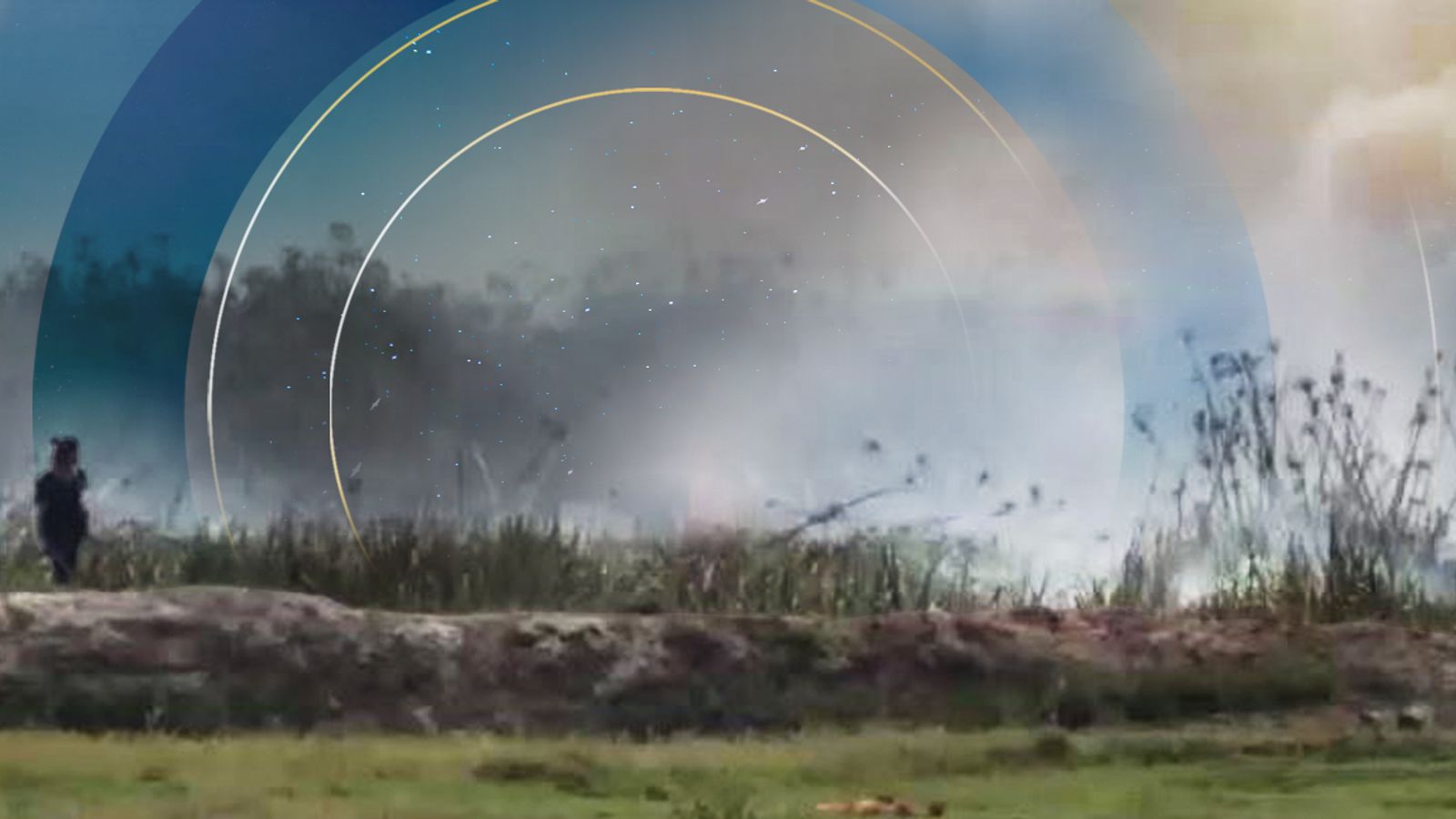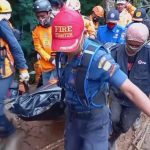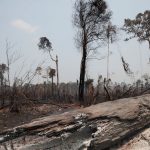The guardians of one of Madagascar’s forests are downright worried.
There is just their small group standing between the Analamazaotra Forest they guard – and destruction. The odds are somewhat stacked against them.
“We have 750 hectares of forest and there is not enough of us,” says Youssouf with devastating understatement.
Please use Chrome browser for a more accessible video player
And any destruction here or in any of the island’s other forests, in one of the world’s most biodiverse rainforests, risks multiple species endemic to Madagascar, including the country’s precious lemurs.
The half a dozen guides who patrol this huge forest are dedicated environmentalists. The head is Christin Nasoavina, an infectiously enthusiastic character who has spent his whole life living, being brought up and working in this area of land. He loves it.
“We will do our best to protect our resources until the end of our days,” he says with a smile. I believe him. But there are a string of factors out of his control.
They all pinpoint the changing and extreme weather patterns as the most serious problem facing them.
Climate change: In dark, dangerous mines, men risk their lives for riches – and add to an environmental nightmare
COP26: Hunger pangs drown out fear of jail as climate crisis sees many Madagascans turn to poaching
Madagascar is on the brink of famine caused by climate change, with children most at risk
“Normally, this is meant to be the rainy season but we have no rain,” says Youssouf. “This is the problem with the climate change.”
Please use Chrome browser for a more accessible video player
And a rainforest without rain has a significant knock-on effect – on the unique plants living here; on the wildlife; on the humans.
The country has been suffering from an extended dry period with parts of the south without sufficient rainfall for more than four years.
Despite being one of the world’s lowest emitters of carbon emissions, Madagascar is probably affected most acutely with increased yearly cyclones, long droughts followed by flooding.
The climatic challenges have increased pressure on the population, the bulk of whom are living below the poverty line – and they’re increasingly turning to cutting trees, poaching wildlife for sale, even eating the animals and plants to survive.
Others (as documented in previous reports) embark on potentially deadly illegal mining – some in the middle of forestland – to try to haul themselves out of poverty but inadvertently also adding to the environmental destruction.
There’s a small section near the forest’s entrance with rows of saplings. Seeds are planted on the reserve to cultivate trees which are endemic to this area and replace those which have been chopped down.
Please use Chrome browser for a more accessible video player
Despite the guides’ daily patrols, and regular forays into the community to explain the importance of maintaining the trees, the locals still venture into this vast wooded area and cut down trees, usually for firewood but sometimes for selling or making charcoal. Youssouf is in charge of conservation and reforestation here.
“It’s really, really very bad because we are growing more trees every year but the people, they are still cutting so that’s why we need help,” he tells us. He means people and funds. People so they can better patrol this vast area – and funds to help them in their battle to protect the treasures here.
“If this continues, we will lose so much wildlife which you can only find here in Madagascar,” Christin continues. “It is not just for our generation but for the future generations. We have to do it for them. It is also an economic issue. Without the forest and the tourists which come all the way from England and France and America to see our lemurs, we will have no jobs and it will affect our economy.”
A member of his team plays a recording he’s made on his phone of the primate known as the singing lemur. The tailless indri is the largest of the lemur species and can reach 15kg in weight.
Please use Chrome browser for a more accessible video player
The indri, along with the bulk of all the other lemur species found only in the wild here in Madagascar are all classified as at risk, making them the world’s most endangered mammal. The singing lemur is deemed to be critically endangered, meaning it faces extinction.
Within seconds of the phone recording being played, the lemurs high above us in the trees emit loud, gutsy, howling responses, leaning their heads back, opening their mouths and really going for it.
Scientists led by a primatologist from Italy’s University of Turin who spent 12 years studying these creatures, concluded recently these lemurs were the only primates apart from humans who were using patterned rhythm.
One of the co-authors of the study likened their rhythm to the pattern of notes employed in Queen’s We Will Rock You. None of the Sky News team hearing the lemurs singing above us in the wild could quite make out Freddie Mercury but my goodness, what a privilege to experience it. “We cannot lose these creatures,” says Christian.
At the first and only frog breeding centre in Madagascar, they’re trying to replenish the range of frogs now also at risk.
“We are known as the frog capital of the world,” says Justin Claude, who runs the breeding centre.
They have more than 400 different species of frog in the country. In the area we are in – in the Alaotra-Mangoro region of east-central Madagascar – they have about 150 alone.
Justin takes out a tiny bright orange frog known as the golden mantella. It’s little bigger than his forefinger and one of the most critically endangered – driven to the point of extinction by loss of habitat, by the drying up of forests and by being caught and sold as pets.
A study in 2020 showed only 2,000 left in their natural habit in Madagascar.
At the centre they’re trying to reverse that by breeding them and then releasing them back into the wild. They’ve already topped up their numbers by releasing several hundred since 2017 but again, lack of funds is mentioned as a key factor in this extremely poor country. And frogs are essential to nature.
“If there is a place without frog,’ Justin explains, ‘There will be a big problem with malaria… because the frogs eat insects, they eat mostly mosquitos and ants so if a place doesn’t have frogs, there must have a big problem with disease.”
Please use Chrome browser for a more accessible video player
The guides also mention the popular practice of “slash and burning” – where trees and plants are burned down to clear land for growing crops. This hugely contributes to the destruction of the natural environment.
The island has a shockingly high rate of deforestation and has lost nearly half of its forests since the 1950s. There’s also a significant amount of corruption and environmental crime – cutting down precious trees and trafficking of the country’s unique wildlife and woods to markets overseas.
Areas in and around forests are being destroyed by illegal gem mining practised by desperately poor people with few choices who reap very little of the benefits of this dangerous trade.
The losers are most immediately the citizens, the wildlife, and the habitat of Madagascar – but in the end, we are all losers as the island’s unique natural treasures are slowly dying in front of us.
Subscribe to ClimateCast on Spotify, Apple Podcasts, or Spreaker
For full coverage of COP26, watch Climate Live on Sky channel 525.
Follow live coverage on web and app with our dedicated live blog.
Get all the latest stories, special reports and in-depth analysis at skynews.com/cop26






















